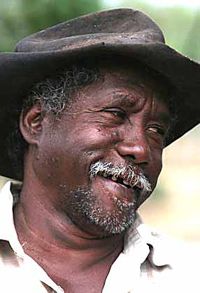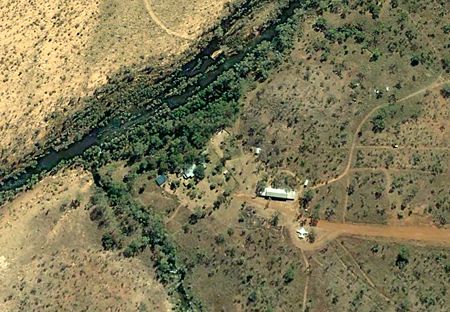Fracking? Enough gas from pollies' bums!
6 December 2015
 By ERWIN CHLANDA
By ERWIN CHLANDA
“I ride a horse. I chase cattle. Full f***ing stop.”
Frank Shadforth (pictured) calls a spade a shovel.
I rang him to discuss the likelihood of fracking on his property in the wonderful Borroloola area, where the mighty Roper River flows into the Gulf of Carpenteria, and where Alice Springs fishers cast their line.
His response: “I’ll call in ISIS if they do. If the politicians want gas there is enough coming out of their rears.”
I asked him if he had a computer. I was exploring the possibility of getting some images emailed.
The answer: See at top.
“Are you Indigenous?” I ask. “Well, I’m pretty bloody black.”
The metric conversion has passed him by: How big is the station? “888 square mile.”
How many tourists do they get a year?
“I can’t tell you. Scott Morrison would dig into my pocket.”
But there is a lot more to Mr Shadforth than being a tough guy from the bush: He’s created an operation of a kind that could contribute massively more to the Development of the North than gas – fracked or otherwise.
The NT Government is hell-bent on letting mining companies have Territory gas for 10% of its value.
And that 10% royalty will go to a government notorious for its incompetence: Per head of population the NT requires five times as much money as do the other Australian jurisdictions (not even counting the money allocated for Aboriginal people). That reduces the value of the royalty to 2%.
Mr Shadforth on the other hand has transformed Seven Emus Homestead, adding a tourist business to the cattle station – the kind of “product” overseas tourists looking for the real Australia are hankering for.
“It’s a normal, simple life,” he says, lots of outdoor adventure. Some of the world’s greatest fishing. No grog.
The station has employed 18 “woofers” from overseas – Willing Workers on Organic Farms in recent times.
The land was taken up by Mr Shadforth’s father, William, as a cattle station in 1953.
Frank took it over 16 years ago. He has a son, a daughter, two granddaughters and thee grandsons – the fourth generation on Seven Emus. (By the way, grandson Wade is fully up to speed on the station’s satellite internet service, even if his grandfather is not.)
Seven Emus is 100 kilometers by road east of Boroloola, on the banks of the Robinson River. From there it’s one hour by boat to the gulf.
Swimming is not recommended: “We have crocodiles. Any size. You can go in ankle deep – knee deep at the most,” says Mr Shadforth.

But fishing doesn’t get any better: barramundi, queen fish, trevally, silver brim, barracuda, jewsfish, sweet lip, stingrays, sharks – “how long have you got?
Mr Shadforth is now worried that the massively water intensive fracking industry will endanger the little paradise he’s built up, especially in a dry year. He says the worry is not just the amount of water used by the miners, but the possible contamination of the station’s supply.
He’s adamant that fracking should be happening only with the consent of the land holder – but he knows he’s fighting a losing battle.
He says the newly required agreements are a farce – they don’t provide a veto right.
In a way his family are double losers: They hold the land under a perpetual pastoral lease from the NT Government. They do not have the same privileges as other Aborigines owning land under the Aboriginal Land Rights Act – some 50% of the NT landmass: Those owners have a veto right to mining and if they do a deal, the Alice Springs News Online understands they get royalties of at least 10% of the wellhead price.



Don’t let the countryman attitude fool you. Frank Shadforth is one of the smartest people I have ever met.
His father had a varied career including being a boxing tent fighter and scraped together enough money to have what was then a sizeable bet on Wodalla in the 1953 Melbourne Cup, which duly saluted at 14-1 and gave him the coin to buy Seven Emus.
When he took it over from his father, Frank began land care practices decades ahead of their time.
He is deeply respected, not the least by the many young men he has taken under his wing over the years when they were tearaways and he turned them around.
He has no time for fools, politicians or spinifex pixies and is as tough as his country.
Good to hear news of Frank. In 1957 I shot a big croc at Borroloola and Frank, then a wee-ai, said: “That’s a bigger bastard altogether.”
He inherited a great sense of humour and plenty of general savvy from his Dad Willy.
The last time I saw Willy he had run out of cash and had to sell half of his station.
He said “I call it Three and a Half Emus now”.
Don’t let the frackers get you down, Frank.
Inspirational but an example of one does not change a picture of overwhelming, long term, entrenched underuse of remote land and resources.
These are vast areas of high welfare dependency, that will suck Federal and Territory funds for the foreseeable future.
And even so needs will not be met, for example it isn’t possible to keep up with housing and maintenance demands when house lifespans are so short.
The Territory is not in a financial position to be too particular about land use.
@ Jason: Let’s talk a little more about Seven Emus.
Quite some time ago, Frank leased out about half of the place to the Australian Wildlife Conservancy, which has created a wildlife sanctuary there (Pungalina if you want someone to look it up and read it to you) doing some cutting-edge research on endangered species.
It was a landmark deal, the first of its kind in Australia.
Having done that, Frank seriously beefed up his tourism business and let’s not forget the rest of it is still a working cattle station.
It’s all run as well as any other station in the Territory and better than most.
Unfortunately, it’s not part of the quarter of the Territory that has been sold of to foreign owners in very recent years. It’s owned and run by a blackfella.
Frank probably wouldn’t give a bugger but I found your description of “overwhelming, long term, entrenched underuse of remote land and resources” offensive because you appear to have a belief that because a blackfella runs it, everyone must be on welfare and the place is a basket case.
It’s not a community, Borroloola is 160km away. Everybody there works, proper job.
I bet you pine for the days when you could pay them in flour and tea. Nobody there has their hand out to the government for housing or anything else.
I particularly enjoyed your last line, “the Territory is not in a financial position to be too particular about land use”.
Seven Emus and Pungalina only work because they are not downstream of Redbank mine, or any one of the numerous other environmental and ecological disasters that litter the Territory in the form of toxic, unrehabilitated mine sites.
Good to hear from you, Ted Egan. I sadly never met Willy; if he was anything like Frank he had to be quite a character.
Magpie, no need to drag race into this.
Commendable though Frank’s work may be it is simply undeniable that there is an overwhelming, long term, entrenched underuse of remote land and resources.
It’s also true that the endemic remote welfare dependency is very expensive and will only become more so.
How will this be paid for?
How will often criticised living remote conditions be maintained, let alone improved?
The Territory is heading for tough times with the end of big projects and the willingness of the new Federal Government to continue to meet all our needs is doubtful when there is a growing Federal budget deficit.
We can lock up the Territory, shut down miners and gas companies and feel smugly green.
But the end result is higher unemployment, worse health, more crime and much more homelessness.
Fracking does need to be environmentally controlled but the new gas pipe line alone will add $20m a year to Territory coffers.
That is money the Territory needs and there is a lot more to come in the future.
By the way a quarter of the Territory has not been sold to foreign interests.
Where did you get the $20m figure from Jason? Michael Gorey did a report in another Territory publication and he advised it is $10m.
Sounds like someone is doing an excellent job of conserving the country he owns (does not matter if he is black or white) but the Territory Government can’t see past the almighty dollar sign, which will leave future generations nothing to live on.
Mining on the other hand does destroy – not only the mined land but surrounding land as well.
The over-populated coastal areas are now wanting to destroy the inland and I bet it is rich, well to do people who want to buy more possessions and holidays but never give back anything.